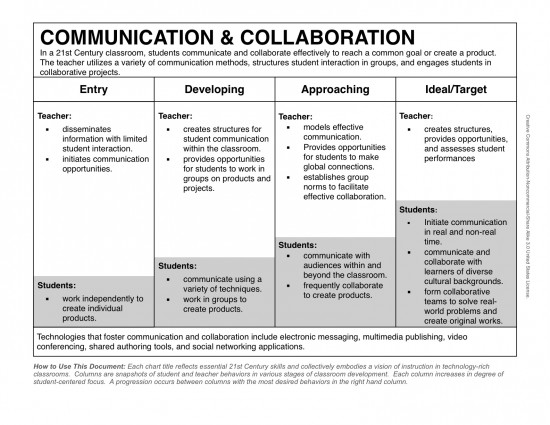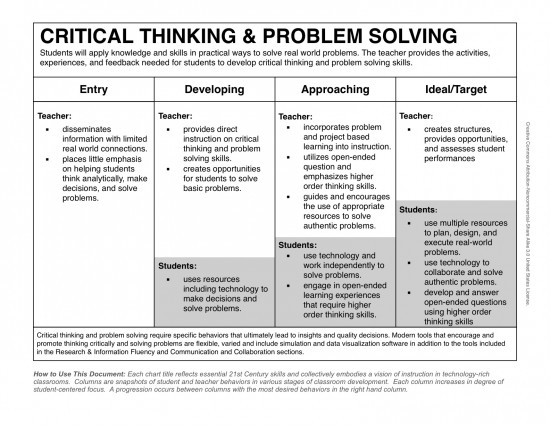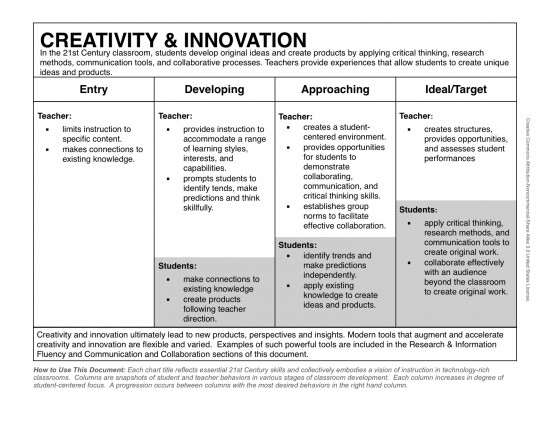We’re on revision 3 of our attempt to describe the 21st century classroom and to make it accessible and actionable for teachers. It’s really easy to say “21st Century Classroom,” it’s much harder to break it down and describe the components in a clear and concise way. We’ve taken three stabs at it and I think we’re getting pretty close. Figure it might be useful to someone.
Round 1 was about 3 years ago. It was a good document but hampered by massive size and too much technology terminology. This hampered adoption pretty severely.
Round 2 was last year and we swung pretty hard in the opposite direction. The focus was on leanness and the technology terminology was dropped. Technology was mentioned but it wasn’t very direct.
Round 3 is embedded below. We kept it lean but added an individual statement about technology and changed the layout to better emphasize how a student’s role changes as the classroom progresses. We also dropped individual documents on assessment and organization believing that both elements are now covered in other components.
These documents can serve several purposes. Our goal was to provide a place to codify our views on 21st century practice- to show the mix of pedagogical changes, 21st century themes and sound use of technology. This allowed for teachers to self-reflect and analyze their own practice. They could then work with their ITRT1 to choose a focus for the year and work on increasing their demonstrated skills in that area.
1 Instructional Technology Resource Teacher





I love that you include teacher look-fors, as well as student look-fors. I appreciate the growth model spectrum, as well. I wonder igf the teacher look-fords under “ideal/target” could be more specific, and if a different heading might better fit that column, such as “proficient” or “practicing.” That would let you add a column for innovatior or mastery in each area where teachers not only develop new practices, but also find ways to share anad scale them. This is important work, and you do a great job showing the interdependency of teachers’ and students’ behavior.
Love the shading of the students.
Chad,
Those are good points. What we’re trying to do is use the rubrics to start the conversation. We have modules (designed to be led by facilitators) with online resources, activities etc. Those modules are going to focus on specifics in the classroom.
I like the column header idea. We’re going to create a variety of data tools around this to help with observations and to get an idea where schools were out. That might be a place to address that as well. Scale is a good point as well. We were talking about how we might look at that during observations and take it into account.
Appreciate you taking the time to comment. I’ll pass them on to the team.
What about adding something about sharing/collaborating in terms of students teaching others for the target column? And for the teacher in the target column, how about some kind of wordage that has the teacher being a co-creator with the students (i.e. the teacher acts as a guide to create, implement projects with the students.)
These are fantastic rubrics, but very vague and general. So I like the idea that they will be linked to resources, activities, suggestions for getting to each level of the rubric. This is perhaps the biggest hurdle that teachers with little tech/ media skills will experience with them.
I also like that it is open enough to adjust for change through time.
Hi Tom,
I really like the easy to read and visualize layout of the charts.
We have been wrestling with the same: – Making the 21st Century Classroom Concrete – here in Manitoba as well.
To see what we are doing in Manitoba check out: http://www.edu.gov.mb.ca/k12/tech/lict/index.html
If you check out the continuum you will see we all agree that ethics and responsiblity, critical thinking, and creative thinking are all requirements in the 21st century classroom.
I appreciate how you’ve described the evolution in your thinking and the revisions that are made in response to it. This illustrates the reality that pieces like these are always living documents and they shift in response to new thinking and learning.
I like how well refined they are–this leaves a lot of room for flexible interpretation and implementation as well. In this way, the rubrics have “legs” that will allow you to learn more as others make use of them and come back to share out what they are discovering!
It would be great if kids and teachers could at some point begin demonstrating how they are using the rubrics and how they are growing around each dimension too. I apologize if you’ve addressed that elsewhere and I’m showing my ignorance here–is that a plan for the future? I can understand how it might be overwhelming to take that plunge immediately. This is exciting work! Thanks for sharing it!
One other thing I’m wondering too–would it be meaningful to encourage teachers to grow in the same ways that students are expected to grow as well within this model? Perhaps this is a separate conversation….wondering, though….
Anglea,
Good questions and some things we have thought about (at least to some degree) but I didn’t get into earlier. To be honest, I figured this would be another post thrown into a deep well of silence but it seems to have connected with a few people.
I’m working on another post that’ll get more into the details of the implementation and how we hope to have things work.
We definitely appreciate the input.
As a librarian tasked with introducing & enforcing Information Literacy skills to a diverse post-secondary group – this is great! Makes my job explaining it to faculty so much easier – thanks.
Wow, such a helpful and thought-provoking post! My mental list of people I want to share it with gets longer by the minute… thank you!
Appreciate that Shelley. It was the work of a lot of people so I’m glad to see it’s useful to others as well.
I’d try to find a way to share this fine work with the ISTE folks.
This is useful and I like the focus on the learning environment.